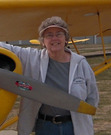Sarah Byrn Rickman's Blog
May 3, 2024
Cornelia Fort WAFS Pilot Earns Sarah a Silver!
Last fall I entered Cornelia Fort WAFS Pilot: Her Life for Her Country in the Benjamin Franklin Book Awards. Cornelia’s story is the ninth biography I’ve written about those remarkable women pilots of World War II. They were known first as the WAFS (Women’s Auxiliary Ferrying Squadron). Badly needed, 28 of them came forward and volunteered to fly “for their country”.
In mid-March, an email from IBPA arrived! Cornelia was a finalist in Teen Non-fiction (13-18 Years), better known now as Y/A or Young Adult non-fiction!!! I was ecstatic! The last six of those nine biographies are specifically aimed at today’s Young Adult Women.
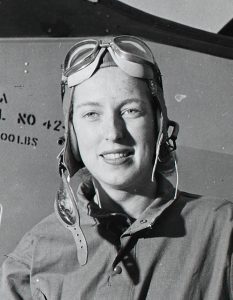 Cornelia Clark Fort
Cornelia Clark FortPhoto courtesy the WASP Archive, Texas Woman’s University
How did this come about? “Why” asked two of my fellow author friends (former teachers) “are you writing these books for adults when it’s our young women, today’s teenagers, girls who NEED them?”
Their Advice Was Right On!STEM (Science, Technology, Engineering and Math) classes have made it clear. Offering, emphasizing these fields to young women in their teen years was LONG overdue. Thank you Nancy Jurka and Jacque Boyd! – my fellow authors from Women Writing the West who nudged me in the right direction.
I’ve been writing in this category for the last eight years. Six “Young-Adult-Women-focused” books in all!
Thank you IBPA for selecting Denver as the location for this year’s awards. I grew up in Denver – back in the day. I’m a proud graduate of East High School (you go Angels!) Now, after many years away, I’m back – living just a “few” miles south … in Colorado Springs! I and my guest were invited to attend the awards ceremony Friday evening, April 26, at Denver’s downtown Hilton. My son Jim in the driver’s seat, we headed up I-25 that Friday afternoon.
Three Happy Finalists at Our Table!What fun! We met several really neat people. Three of “we FINALISTS” (all different categories) gathered at our table with our respective friend, supporter, spouse, or family member. All three of us remained Finalists! Sobeit!!!
Congratulations to each category’s winners! And we thoroughly enjoyed joining the rest of crowd in the vast dining room to whoop it up with our cheers for the winners. The room rocked with each one named. All in all, a terrific evening.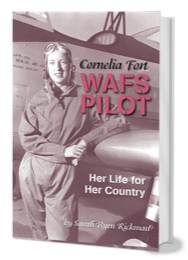
Thank you “IBPA Benjamin Franklin Awards”! What a delightful evening! We – winners and finalists alike – owe you our thanks for inviting us, not to mention reading our precious manuscripts, and yes, for recognizing our books – and we the authors – with your awards! And thanks to you book buyers out there who read our offerings. We love you!!!
Read an excerpt from Cornelia Fort WAFS Pilot here
IBPA stands for Independent Book Publishers Association (IBPA-online-org)
Check out Cornelia Fort WAFS Pilot and my other books on Amazon.The post Cornelia Fort WAFS Pilot Earns Sarah a Silver! first appeared on Sarah Byrn Rickman.
April 4, 2024
Cornelia Fort, Finalist in IBPA Benjamin Franklin Book Awards!
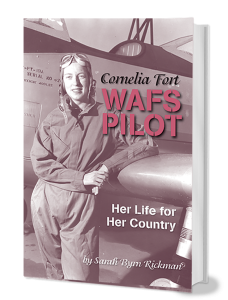 Cornelia Fort, WAFS PilotCornelia Takes Flight Again!
Cornelia Fort, WAFS PilotCornelia Takes Flight Again!Friends, I gotta brag – again! Cornelia Fort WAFS Pilot: Her Life for Her Country has been named a finalist in the 36th Benjamin Franklin Independent Book Publishers Association (IBPA) competition.
The festivities and announcement of winners takes place, April 26, in Denver, Colorado. (Close to home!) I plan to be there.
Cornelia’s story is told in my sixth Y/A-focused book about America’s women pilots who flew in World War II. Published last year, it is eligible for the 2024 competition. The category is TEEN-Nonfiction (13-18 Years). I am so very thankful for the growing interest in biographical works written for today’s young women readers. I’m a big believer in the power of biography.
What carries this story is Cornelia’s relentless commitment. All are obvious given her patriotism, sense of duty, and, frankly, her sheer nerve. Yet she dies in a crash that should never have happened. In all, 38 of these young WASP pilots died serving their country in WWII. None of their flying was done abroad. They were never in – nor intended to be – in combat!
Today’s Aviation Needs Young Women!In 2017 I set out to write a book specifically FOR Young Adult women. Why? To reach motivated, ambitious, forward-looking young women readers potentially interested in STEM (Science, Technology, Engineering and Math). Today, these aviation fields are open to well-qualified young women.
My interest in writing biography for young women readers began when two of my now-retired teacher friends convinced me I should try it. “Today’s young women readers are the ones who need these stories you are writing,” they told me. Thank you again Jacque and Nancy!!! Enter the book B.J. Erickson WASP Pilot. In 2018, BJ’s story won the Gold Medal in Story Circle Network’s Sarton Award competition for Young Adult Non-Fiction. In 2019, it also won the Combs-Gates Award from the National Aviation Hall of Fame for books that tell the personal rather than technical side of aviation. What a way to begin!!!
That one book ultimately grew to six. All are about the women who flew for the Ferrying Division, U.S. Army Air Forces, in World War II. From October 1942 to December 19, 1944, those women pilots flew nine million miles; moved a total of 12,650 aircraft; and flew more than one hundred fifteen thousand pilot hours in the 27 months they served.*
In all, 1,102 women – known as Women Airforce Service Pilots (WASP) – flew for the United States in WWII. Daily they flew whatever type of aircraft and mission to which they were assigned.
Nancy Love, in Command136 WASP Ferried Fighters – One Seat, No Copilot!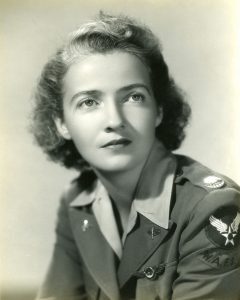
Of the 303 who served in the Ferrying Division under leader Nancy Love, 136 of the women qualified as “pursuit pilots.” Throughout 1944, those women flew single-cockpit, single-engine fighter aircraft from the factories to the docks on our Atlantic and Pacific shores. From there, U.S. Liberty ships took the planes to the battle zones where male fighter pilots were on the lookout for the arrival of those badly needed combat aircraft.
Twenty-six of Nancy’s women also qualified to fly the powerful twin-engine P-38 fighter, “Lightning”. Five qualified to fly the awesome “Black Widow” – the twin-engine P-61 night fighter. That aircraft – the first equipped with radar – came into the war late.
And now, this year – 2024 – Cornelia Fort’s story has captured attention. It is a FINALIST in the Benjamin Franklin TEEN-Nonfiction 13-18 competition. For that I am MOST honored! Sure hope I win! Looking forward to April 26th!
Thank you all for reading my posts! Please take a look at my 13 books available on Amazon.
Notes:
Source: Women Pilots in the Air Transport Command: Lieutenant Colonel Oliver LaFarge.
*Ferrying Division Historical Officer Captain Walter J. Marx – the man who compiled all this information – “derived much information through conversations with Nancy Love, Executive for WASP, and the key figure in the whole history of the women pilots within the command.” *Historical Branch, Air Transport Command.
The post Cornelia Fort, Finalist in IBPA Benjamin Franklin Book Awards! first appeared on Sarah Byrn Rickman.
March 14, 2024
Living Legend Award for WASP Jerrie Badger
“Don’t let us be lost,” says Jerrie Phillips Badger, who served as a WASP (Women Airforce Service Pilots) in World War II. “Women are so often taken for granted, assuming that they are the underdog – and they are not.”
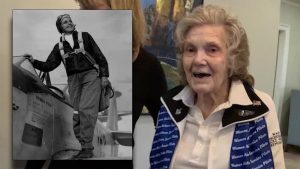 WASP Jerrie Phillips Badger, Class 44-10
WASP Jerrie Phillips Badger, Class 44-10
Badger, 102, knows of what she speaks. In the time these women flew for their country – September 1942-December 1944 – they experienced both good and bad treatment. Where they served, under whom, and what their jobs entailed, are what mattered.
This past January 15, Jerrie received the coveted Living Legend Award from the Women’s Military Memorial in Washington, D.C. Sharon Skellie, an Ambassador from the Memorial, travelled to Atlanta to make the presentation.
WHO WERE THE WASP?Eleven-hundred-two women pilots qualified to fly for the U.S. Army Air Forces in WWII. Of that number, 303 served as ferry pilots – flying and delivering critically needed higher-powered aircraft to their assigned destination in the continental United States. Another group towed gunnery targets for young recruits on the ground learning to shoot at moving targets.
Yet another contingent test-flew repaired aircraft before the men were allowed to fly them again. Some taught fledgling male pilots to fly. Others flew non-flying officers and personnel to meetings at other air bases. The WASP performed any and every job the AAF handed them – and they did it well! Many a commanding officer sang their praises.
Jerrie was a member of the very last WASP class. They graduated December 7, 1944, and served only 13 days of active duty. But prior to that, before the WASP were shut down December 20, she and her 44-10 classmates had seven months of very thorough training. Jerrie’s classmate Marty Wyall told this author, “Class 44-10 had the best training of all!”
UPGRADE THE TRAINING PROGRAM!The earliest women to report for training had at least 200 hours of flight time. But by the time the fourth class entered in spring 1943, there were few experienced pilots remaining. A couple of accidents suggested the need of more training. Beef up instruction now! In the fall of 1943, Colonel William H. Tunner, commander of the Ferrying Division, ordered the men training the fledgling WASP at Sweetwater to come up with the absolute best training possible. The women of the last ten classes – all 1944 graduates – benefited the most from this. Jerrie proved to be a very good example.
On September 5, 1944, she wrote home:
Dear Mother & Alice,
There was quite a to-do on the 1st of September.
At 6 o’clock a girl went up to shoot a touch-and-go landing at the Auxiliary Field. She lowered her gear. The landing gear did not lock in the down position. The pilot called the tower for instructions.
The tower told her fly over to the practice area and dive from 6,000 feet – at 150 mph – then perform a quick pull up and release the gear at the same time. She did it. – No luck.
By 7 o’clock all the other planes had returned to the field. The Tower told her to fly directly over the field doing coordination exercises. This meant rolling the plane from 75-degrees on one side to 75-degrees to the other. At the same time she had to keep the nose of the plane on a specified point –– No luck!
GIVE IT ONE MORE TRY!They had her climb to 6,000 feet again and do several power dives – diving straight down toward the runway. She did several at 150 mph, then upped her speed to do one at 187 mph. Her instructions were – when her air speed reached 187 mph, lower the gear, push the power button, and pull straight up. The plane shot up and almost went over backwards. The engine cut out. The pilot semi-blacked out. Then conscious again, she pushed the nose down.
This time the engine caught!
She called the tower. “What happened?’ she asked.
She recognized the reassuring voice that came back. She’d already had a civilian check ride that day and now – by chance – the same instructor who checked her out earlier just happened to be the one talking to her now! “Lower the gear and land on the runway” he told her.
“ATTA GIRL!!!”“ Atta-girl!” he called out to her now as she turned on her final approach. “OK, now just make a normal landing, let the plane roll to a stop.” Then he reminded her to secure herself, her harness, and her seat. “So your head won’t hit the instrument panel.”
Students, officers, her former instructors, her present instructor, the fire truck, the ambulance, all were there watching. Pilots in other planes listening on their radios later said her voice was very calm at all times. As the plane got closer to the runway you could hear a pin drop. They expected the wheels to crumble under if there was the slightest bounce.
She landed in a perfect 3-point! Everyone said it was the best landing they’d ever seen. The Tower told her to cut all switches and get out immediately!
It was after 8 o’clock when she climbed into the fire truck for the ride to the hanger where everyone was waiting and shouting. Much shaking of hands, patting of backs, etc. Her instructor shook her hand and put his arm around her. Someone gave her a cigarette. Then the girls made a saddle of their hands and carried her off.
“WHO WAS THAT PILOT?”“Who was that pilot?” Jerrie wrote at the bottom of the last page:
“Have you guessed yet? – Yes, that was me!”
#####
EDITOR’S NOTES* Today, only six of the 1,102 WASP who served in WWII survive.Atlanta resident Martina Schmidt, retired military, contacted the Military Women’s Memorial in Washington D.C. She spoke with Ambassador Sharon Skellie, telling her that Jerrie had not yet received the Living Legend Award. Sharon acted. She came to Atlanta and personally presented Jerrie with the proclamation in January. Schmidt is the founder of She Served Initiative – a newly established, non-profit organization that honors America’s Women in the Military. Jerrie Badger’s story is in the March copy of the magazine published by She Served Initiative.The Military Women’s Memorial Living Legend Program recognizes military women whose stories of service provide inspiration and example for all to appreciate. These stories serve to increase the public awareness of women’s contribution to America’s national defense and deserve special recognition. The Living Legend Proclamation is awarded to women veterans for any of the following reasons:Women Veterans who reached their 100th birthday.Women whose story of service are particularly inspiring – not necessarily because she achieved a rank or accomplished a “first,” but because of their commitment to serve and how that service guided/inspired their life even after discharge,Retirements from a career of notable service.See Sarah’s 13 books about the WASP on Amazon.
The post Living Legend Award for WASP Jerrie Badger first appeared on Sarah Byrn Rickman.
WASP Jerrie Phillips Badger Receives Living Legend Award
“Don’t let us be lost,” says Jerrie Phillips Badger, who served as a WASP (Women Airforce Service Pilots) in World War II. “Women are so often taken for granted, assuming that they are the underdog – and they are not.”
 WASP Jerrie Phillips Badger
WASP Jerrie Phillips BadgerBadger, 102, knows of what she speaks. In the time these women flew for their country – September 1942-December 1944 – they experienced both good and bad treatment. Where they served, under whom, and what their jobs entailed, are what mattered.
This past January 15, Jerrie received the coveted Living Legend Award from the Women’s Military Memorial in Washington, D.C. Sharon Skellie, an Ambassador from the Memorial, travelled to Atlanta to make the presentation.
Who were the WASP?
Eleven-hundred-two women pilots qualified to fly for the U.S. Army Air Forces in WWII. Of that number, 303 served as ferry pilots – flying and delivering critically needed higher-powered aircraft to their assigned destination in the continental United States and Canada. Another group towed gunnery targets for young recruits on the ground learning to shoot at moving targets.
Yet another contingent test-flew repaired aircraft before the men were allowed to fly them again. Some taught fledgling male pilots to fly. Others flew non-flying officers and personnel to meetings at other air bases. The WASP performed any and every job the AAF handed them – and they did it well! Many a commanding officer sang their praises.
Jerrie was a member of the very last WASP class. They graduated December 7, 1944, and served only 13 days of active duty. But prior to that, before the WASP were shut down December 20, she and her 44-10 classmates had seven months of very thorough instruction. Jerrie’s classmate Marty Wyall told this author, “Class 44-10 had the best training of all!”
Thanks to Colonel William H. Tunner, Ferrying Division commander, the men who trained the fledgling WASP at Sweetwater throughout 1944, perfected the best training program possible and the women of the last ten classes benefited the most from it. – Jerrie proved to be a very good example.
On September 5, 1944, she wrote home:
Dear Mother & Alice,
“There was quite a to-do on the 1st of September.
“At 6 o’clock a girl went up to shoot a touch-and-go landing at the Auxiliary Field. She lowered her gear. The landing gear did not lock in the down position. The pilot called the tower for instructions.
“The tower told her fly over to the practice area and dive from 6,000 feet – at 150 mph – then perform a quick pull up and release the gear at the same time. She did it. – No luck.
“By 7 o’clock all the other planes had returned to the field. The Tower told her to fly directly over the field doing coordination exercises. This meant rolling the plane from 75-degrees on one side to 75-degrees to the other. At the same time she had to keep the nose of the plane on a specified point –– No luck!
They had her climb to 6,000 feet again and do several power dives – diving straight down toward the runway. She did several at 150 mph, then upped her speed to do one at 187 mph. The young pilot’s instructions were – when her air speed reached 187 mph, lower the gear, push the power button, and pull straight up. The plane shot up and almost went over backwards. The engine cut out. The pilot semi-blacked out. Then conscious again, she pushed the nose down.
This time the engine caught!
“She called the tower: ‘What happened?’ she asked.
At that point she was instructed to raise the gear and make a crash landing off the runway … This was quickly amended to ‘lower the gear and land on the runway.’
“She’d already had a civilian check ride that day and now – by chance – the same instructor who checked her out earlier just happened to be the one instructing her now!
“ ‘Atta-girl!’ he called out to her now as she turned on her final approach. ‘OK, now just make a normal landing, let the plane roll to a stop.’ Then he reminded her to secure herself, her harness, and her seat. ‘So your head won’t hit the instrument panel.’
“Students, officers, her former instructors, her present instructor, the fire truck, the ambulance, all were there watching. Pilots in other planes listening on their radios later said her voice was very calm at all times. As the plane got closer to the runway you could hear a pin drop. They expected the wheels to crumble under if there was the slightest bounce.
“She landed in a perfect 3-point! Everyone said it was the best landing they’d ever seen. The Tower told her to cut all switches and get out immediately!
“It was after 8 o’clock when she climbed into the fire truck for the ride to the hanger where everyone was waiting and shouting. Much shaking of hands, patting of backs, etc. Her instructor shook her hand and put his arm around her. Someone gave her a cigarette. Then the girls made a saddle of their hands and carried her off.”
Who was that pilot? Jerrie wrote at the bottom of the last page:
“Have you guessed yet? – Yes, that was me!”
Atlanta resident Martina Schmidt is the founder of She Served Initiative – a newly established, non-profit organization that honors America’s Women in the Military. Jerrie Badger’s story is in the March copy of the magazine published by She Served Initiative.
Martina contacted the Military Women Memorial in Washington D.C. She spoke with Ambassador Sharon Skellie, telling her that Jerrie had not yet received the living legend award. Sharon acted. She came to Atlanta and personally presented Jerrie with the proclamation in January.
Editor’s note: Today, only six of the 1,102 WASP who served in WWII survive. Jerrie is one of them. Sadly, we lost two more of our WASP in early February.
Editor’s note #2: Thanks to Martina Schmidt for setting up the meeting between Jerrie and Sharon Skellie, the Ambassador from the Women’s Memorial. Martina is, herself, retired military. She is also the founder of the small non-profit She Served Initiative, celebrating women military veterans.
The Military Women’s Memorial Living Legend Program recognizes military women whose stories of service provide inspiration and example for all to appreciate. These stories serve to increase the public awareness of women’s contribution to America’s national defense and deserve special recognition. The Living Legend Proclamation is awarded to women veterans for any of the following reasons:
Women Veterans who reached their 100th birthday.Women whose story of service are particularly inspiring – not necessarily because she achieved a rank or accomplished a “first,” but because of their commitment to serve and how that service guided/inspired their life even after discharge,Retirements from a career of notable service.For the story of why the last class had such good training, you might read my book, WASP of the Ferry Command. It is the history of the 303 WASP who flew for the Ferry Command in WWII. Published 2016 by the University of North Texas Press. I think you’ll like it. – Sarah R
The post WASP Jerrie Phillips Badger Receives Living Legend Award first appeared on Sarah Byrn Rickman.
November 2, 2023
Dedication Is November 9th
Cornelia Fort is one of the most recognized names among the 1,102 American women who flew for the U.S. Army Air Forces in World War II. They were known originally as the WAFS (Women’s Auxiliary Ferrying Squadron) and after August 5, 1943, as WASP (Women Airforce Service Pilots.)
 Cornelia Clark Fort
Cornelia Clark FortPhoto courtesy the WASP Archive, Texas Woman’s University
The Nashville Tennessee native – the third woman to join the WAFS in early September 1942 – first made headlines on December 7, 1941 … Pearl Harbor Day. She was the first person that fateful morning to “spot” and then encounter the approaching formation of Japanese warplanes.
A seasoned flight instructor at age 22, this young woman was aloft over Pearl Harbor – adjacent to the Hawaiian island of Oahu – that Sunday morning, giving a flying lesson to a young student pilot. In the distance she saw moving specks. “What are they? … A flock of birds?… Too big! … Airplanes?!!!”
She squinted through the windscreen of her Interstate Cadet trainer aircraft. The specks – yes, they were airplanes – and they were coming on fast!
“Let’s Get Outta Here!”“What’s that, Miss Fort?”, asked her student Ernest Suomalo. He too had spotted them. As he spoke, one of the airplanes peeled off from the formation and headed straight for them.
“My airplane” Cornelia yelled, grabbing the controls away from her student. “Let’s get outta here!” She jammed the throttle wide open and pulled up and out of the path of the oncoming plane. It swept beneath them, rattling the celluloid windows. The aircraft bore the Rising Sun insignia of the Japanese Empire.
At that moment, WWII came to America.
Battleship Row Was THE Target!The Hawaiian Islands, a United States protectorate, were under attack. Bombs rained down on Pearl Harbor, striking the ships docked below. (The main objective of the attack was to decimate US naval power in the Pacific by destroying the battleships moored along Battleship Row.) [1]
Bombs also fell on the adjacent city of Honolulu and elsewhere on the island of Oahu, including the Army’s Schofield Barracks. Planes parked adjacent to Army Air Forces’ hangars and runways were destroyed. Amidst that chaos, Cornelia landed safely, albeit in a hail of gunfire. A Japanese plane had zeroed in on them. She and Suomalo leaped from their aircraft and ran into the hangar for shelter.
Instant fame! And from there, Cornelia – now a heroine to her fellow Americans – went on to serve her country in WWII. In fall 1942, Cornelia and her fellow WAFS pilots were employed by the U.S. Army Air Forces, as Civil Service civilians. Their first job was to ferry (move) small training aircraft from the factories to the flight training bases. There, young men, America’s future fighter and bomber pilots, were gathering to learn to fly.
A Senseless Accident …Tragically, Cornelia did not survive the war. In March 1943, while on a group ferrying mission from California over a lonely stretch of west Texas on their way to Dallas, a midair collision took her life. Her aircraft collided with one flown by a young male ferry pilot. She died. The young man survived. An investigation of the crash exonerated Cornelia of any blame.
Cornelia was, of course, one of so very very many this country lost in that long ago war. But America survived.
Fortunately, Cornelia’s story did not die with her. She had begun writing her “story of the WAFS,” only to have her manuscript destroyed when flames enveloped the Fort family home in December 1942. But Cornelia’s story – and those of her fellow WAFS, and the WASP – live on.
Two Biographies Tell Cornelia’s Story
I am the author of Cornelia Fort WAFS Pilot: Her Life for Her Country, published Spring 2023. This book is geared in particular for our young women readers of today. I and so many others want girls in their teens to have the opportunity to read and learn about these daring, incredible women pilots of WWII. Adults, too, may find it a good read.
My friend Rob Simbeck is the author of Daughter of the Air: The Brief Soaring Life of Cornelia Fort. (1999). Rob’s book is Cornelia’s full biography, much depth and detail.
Dedication of Cornelia’s CollectionNext week on November 9, the WASP Archives – located at the Blagg-Huey Library on the campus of Texas Woman’s University, Denton – will unveil and dedicate the Cornelia Fort Collection. Among the surviving artifacts are her papers, her writings, her letters, her original pilot’s license, and her final logbook that tells the story of Sunday December 7, 1941. All her other logbooks burned in the fire at Fortland.
A quick explanation for the uninitiated: Cornelia was a member of the original WAFS – the Women’s Auxiliary Ferrying Squadron, established by WAFS leader Nancy Harkness Love in September 1942. In August 1943, after Cornelia’s death, the WAFS – along with a second, larger group of young women who were, by then, learning to fly “the Army way” down in Texas – were incorporated into one organization, the Women Airforce Service Pilots (WASP). That is the name under which all 1,102 of the women pilots who served America in WWII are known today.
Only Nine of the WASP Are Still With UsAs I write this, only nine of these women are still with us. We who have known so many of them, miss these incredible women. They are a precious piece of America’s WWII legends.
###
https://www.military.com/base-guide/schofield-barracksfort-shafter
The post Dedication Is November 9th first appeared on Sarah Byrn Rickman.
September 15, 2023
IWASM: Lifetime Achievement Award
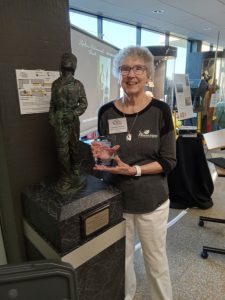 Sarah, standing beside THE iconic WASP statue, shows off her award.
Sarah, standing beside THE iconic WASP statue, shows off her award.
September 1, 2023, the International Women’s Air & Space Museum named me the 2023 recipient of their Lifetime Achievement Award. The second woman on whom they have bestowed this honor, I follow in the footsteps of Caroline “Connie” Luhta, the recipient of IWASM’s first Lifetime Achievement Award – in 2022.
The following is inscribed on my award: “On behalf of the museum and communities around the world, thank you for your tireless efforts to preserve and showcase the history and experiences of women in World War II aviation. Your dedication and advocacy ensures the WAFS and WASP stories live on for generations to come.”
And … the museum asked me to give a short speech.
This Is What I Said …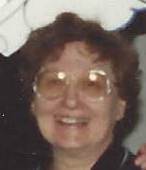 Joan Hrubec
Joan Hrubec“Three women – Joan Hrubec, Nadine Nagle, and Nancy Batson Crews – are the reason I am here tonight. Collectively, the three of them put me on this journey that literally changed my life. Joan was the administrator of IWASM when it located in downtown Centerville, Ohio (suburban Dayton) in 1986. She made IWASM tick in “the ’80s and ’90s” in Centerville and in the early 2000s in Cleveland. Joan was “a walking encyclopedia of women’s aviation.” She opened up that world to me. I first met Joan when she and IWASM board chair Nancy Hopkins Tier and vice chair B Steadman came to ask me – then the editor of the Centerville-Bellbrook Times – would I write an article about the new museum?
IWASM Held the History of My Heroines…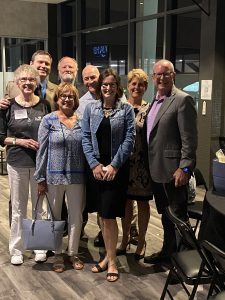 Top left to right: Chuck Rickman, Bob and Bill Arthur, Laurie Arthur, Andy Czajkowski. Front row, Sarah Byrn Rickman, Mary and Alex Czajkowski.
Top left to right: Chuck Rickman, Bob and Bill Arthur, Laurie Arthur, Andy Czajkowski. Front row, Sarah Byrn Rickman, Mary and Alex Czajkowski.… Amelia Earhart, Louise Thaden, and all the other women pilots of note. And the museum had chosen to settle in my town! I was delighted! I ran the article on the front page and I became an IWASM advocate. A year or so later, Joan asked me if I might write about Dayton-area IWASM member and supporter, WASP Nadine Nagle.
This sweet, lovely woman literally brought the WASP (Women Airforce Service Pilots) to life for me. Nadine had never been in an airplane but when her husband of less than a year died in January 1943 – in a B-24 crash-landing in England – she made a decision. Our country was at war. She would fly in his place.
Nadine entered training with the next to last WASP class (44-9), April 13, 1944. She graduated November 8 and was posted to South Plains Army Air Base in Lubbock, Texas. She actively flew whatever she was assigned during those final six weeks of the WASP existen c e in November-December 1944. Nadine and I became close friends. We lost her in 2018, a month before her 100th birthday.
Two Jobs, Two Novels, and a Masters Degree
In 1989 I left the newspaper to pursue my dream of being an author. What followed was a very busy ten years.
First I took on two freelance jobs: writing and editing for the Kettering Foundation and writing and editing the City of Centerville’s
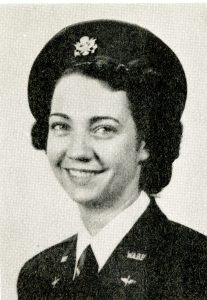 Nadine Nagle
Nadine Naglebimonthly newsletter. I also enrolled in the non-residential Individualized Master of Arts program at nearby Antioch University Ohio. Finally I was on track to get my masters degree in creative writing. FYI: During the long days of Covid, I took on the extensive rewriting of the novel that WAS my master’s thesis. Titled Quilted Lives it is now making the rounds to potential publishers, courtesy of my agent Liz Trupin.
On the side I volunteered for IWASM. Joan and I started a lecture series and decided to gather and present an eight-person WASP panel. Nadine would lead it. But we were missing an Original WAFS – a representative of the Women’s Auxiliary Ferrying Squadron, the 28 women Nancy Love brought together prior to the organization of the WASP.
Our WASP Panel Was a Hit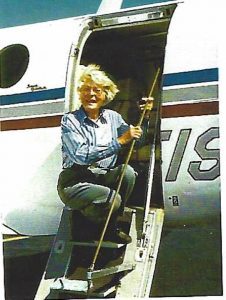 Nancy Batson Crews
Nancy Batson CrewsThe WAFS were the first women to ferry U.S. aircraft in WWII. Recently I had read about one of them, Nancy Batson Crews. Her story fascinated me, so I suggested we invite her to represent the WAFS as part of our WASP panel. She agreed to come. Nadine and I picked her up at the Dayton Airport. Our WASP panel discussion was a hit!!!
Nancy and I became close friends. I finally gathered the courage to ask if she would let me write her biography. “No, Sayruh,” said the Alabama native, “I want you to write the story of Nancy Love and the WAFS.” That is when my life changed! “How?” I asked. I envisioned a lot of traveling, interviewing eight women scattered across the U.S.!
“I’ll Have a Reunion,” said NancyShe invited the other eight living WAFS to come to the reunion, which she held in Birmingham in June 1999. She did this so I could meet, get to know, and interview the WAFS for “our” book. Five of them came. What a time we had!!! Nancy’s introduction led these marvelous women to trust me and to readily tell me their wartime WAFS – and later WASP – stories. I was in Heaven! I went to work on the book, the story of Nancy Love and the 28 WAFS.
It is to Nancy Batson Crews that I owe the fulfillment of my life’s dream – my success as an author. It began when my book – The Originals, the Women’s Auxiliary Ferrying Squadron of World War II – was published by Disc-Us Books in July 2001. The rest is history. I’ve now had the privilege of writing about the WAFS and the WASP in, as of now, 13 books … and counting!
The post IWASM: Lifetime Achievement Award first appeared on Sarah Byrn Rickman.
July 25, 2023
FOLKS, I GOTTA BRAG!
On September 1, the International Women’s Air and Space Museum (IWASM) in Cleveland, Ohio, is honoring yours truly with their Lifetime Achievement Award. And I have to say, my 37-year journey with IWASM has been an incredible one.
In 1986, I was the editor of the twice-weekly Centerville-Bellbrook Times, Centerville, Ohio. A job I absolutely loved! Two representatives from IWASM came to the newspaper to talk to me about their new museum that was opening in “MY” town. They hoped for an article about IWASM. They got it!!!
HERE WAS MY CHANCE TO SALUTE WOMEN PILOTSI was more than delighted. These women were members of the Ninety-Nines, the Organization of Women Pilots – founded in 1929 by my heroine Amelia Earhart and 98 other women pilots.
At age 13, I discovered Amelia between the pages of a school textbook. From that day forward I wanted to learn to fly! Now Amelia’s story and the stories of other well-known women pilots were coming to my town. Joan Hrubec, the museum’s administrator, became a friend and a mentor.
A walking encyclopedia of women in aviation, Joan taught me well. She and the many other women pilots who came to the museum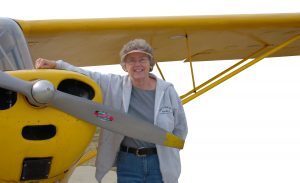 encouraged me to learn to fly. It took 20 more years, but I did it! Now I, too, am a Ninety-Nine. And I still gladly serve as an IWASM “advisor.”
encouraged me to learn to fly. It took 20 more years, but I did it! Now I, too, am a Ninety-Nine. And I still gladly serve as an IWASM “advisor.”
That the WASP, the Women Airforce Service Pilots flew for the USA in World War II was the government’s best kept secret. We, the generation who grew up during THE WAR, never heard about the WASP.
I left the newspaper in 1989 and Joan promptly asked me to be IWASM’s PR person. My first assignment: write an article about Nadine Nagle, our local Dayton Ohio WASP. Nadine was a joy to know! She and I remained close friends until her death in 2018 – just shy of her 100th birthday. Nadine and Joan opened up to me what became my new mission in life – to let the world know who the WASP were and what they did for their country in WWII.
Nancy Batson Crews came to IWASM in January 1992 to be part of a WASP panel discussion. From Nancy I learned about the Women’s Auxiliary Ferrying Squadron (WAFS), the 28 women pilots who PRECEDED the WASP. Nancy Love, a stellar 1930s-era pilot, founded the WAFS in September 1942! In 1943, they became part of the WASP.
‘PLEASE WRITE ABOUT NANCY LOVE AND THE WAFS’I left IWASM in 1994 to go back to school and get my master’s degree in creative writing. My ultimate goal was to write BOOKS, which became my “later in life” career. Thanks to Nancy, Nadine and Joan, when I began to write books, I chose to write about America’s women pilots – the still relatively unknown WAFS and WASP of World War II.
My first, The Originals, came from Nancy Crews’s personal request that I tell the story of Nancy Love and the WAFS. Nancy introduced me to the other surviving WAFS who added much to the story. I went on to meet and get to know many WASP. Now, I have a total of 13 WAFS/WASP books “out there.” Joan, Nadine and Nancy are directly responsible for whatever I did to earn this amazing recognition from IWASM.
Last year, Connie Luhta was the first woman to receive IWASM’s Lifetime Achievement Award. Connie is a friend, a longtime IWASM leader, do-er, and top notch professional pilot! Take it from me, if anyone deserves this award, it is Connie. I am in very good company!
Here is the announcement/invitation from IWASM that went out July 19:

The International Women’s Air & Space Museum (IWASM) will host its popular event, Corks on the Concourse (Corks) Friday, September 1, 2023, from 6:00 p.m. to 9:00 p.m. Happening the night before the official start of Cleveland National Air Show weekend, Corks invites community members to this engaging, community event which provides crucial support to IWASM’s work to preserve, educate and inspire our communities about the role of women in all areas of air and space.
Guests can expect to engage in an exclusive wine-tasting experience featuring Ohio-based wineries. Test their trivia knowledge with special lightning round prizes, and join us as we honor our 2nd Annual Lifetime Achievement Award winner, historian, author, mentor, women in WWII aviation advocate, and pilot Sarah Byrn Rickman. IWASM will also welcome back two fellow women-owned businesses, The Energy Producer Jaime Kravitz and Karen King Catering. Towards the end of the evening, baskets and one-of-a-kind experiences will be up for bidding in the silent auction.
SUPPORT the INTERNATIONAL WOMEN’S AIR & SPACE MUSEUMCorks is an opportunity to ensure the International Women’s Air & Space Museum continues to strengthen Cleveland and Northeast Ohio’s cultural heritage tourism industry and serve our communities through educational programming for years to come.
Tickets are required. Tickets are $80 for non-members or $70 for IWASM members. IWASM is offering a special bundle for discounted tickets with the purchase of a one-year membership for $120. All in-person tickets include a commemorative wine glass and wine samples. Also offered are $55 Designated Driver (non-alcoholic) and $25 Virtual tickets.
Tickets may be purchased online on the Events page at www.iwasm.org or by calling 216-623-1111. The deadline to RSVP is August 30, 2023. For more information, call the museum or email info@iwasm.org.
IWASM is a 501(c)3 nonprofit museum with the mission to preserve, educate, and inspire its communities about the history and culture of women in all areas of aviation and aerospace. Located inside Cleveland’s Burke Lakefront Airport, exhibits are free of charge seven days a week from 8-8:00, offering guided tours and programs by appointment. For more information, visit www.iwasm.org or call 216-623-1111.
The post FOLKS, I GOTTA BRAG! first appeared on Sarah Byrn Rickman.
May 25, 2023
The WASP: In Observation of Memorial Day
Thirty-eight WASP perished performing their patriotic calling — flying for their country in World War II. All were young women, age 20 to early 30s — women whose futures would never be realized.
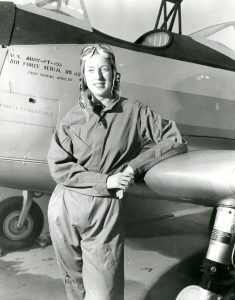 Cornelia Fort
Cornelia FortCornelia Fort, a southern gentlewoman from Tennessee, loved flying. She also was on her way to becoming a proven writer. Early on, Cornelia dedicated herself to writing the definitive story of Nancy Love’s original WAFS (Women’s Auxiliary Ferrying Squadron) — and, who knows, possibly the unfolding WASP saga still to come.
But Cornelia, the second woman Nancy Love accepted into the WAFS, September 1942, was the first woman pilot to die on active service for the United States military. Ferrying a basic trainer from California to Texas, she was the victim of a senseless mid-air collision, March 21, 1943. The other pilot (male) survived.
Telling the WAFS’ Story As It UnfoldedMuch admired and well-liked by her fellow WAFS, Cornelia had the drive, dedication and resources to tell the WAFS story when it was fresh.
In all, Nancy Love lost three of her original WAFS.
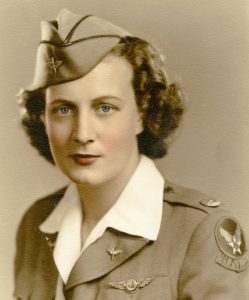 Dorothy Scott
Dorothy ScottSecond WAFS to perish was friendly, outgoing, all-American girl Dorothy Scott. From tiny Oroville, Washington, just south of the Canadian border, her desire to fly took her to the University of Washington, into the Civilian Pilot Training Program there, and thus to the WAFS.
Like several of the younger WAFS, she had just over the minimum 500 hours required for admission — she had logged 504 — but she was a truly fine pilot in whom her mentor, Nancy Love, saw a lot of potential.
Dorothy served as flight leader on ferrying trips with the new graduates of the Women’s Flying Training Detachment (WFTD) who joined the 5th Ferrying Group squadron in Dallas. She also was the welcoming liaison for the new WASP joining the Dallas ferrying group. She earned Love’s trust. Nancy chose her for a copilot on a C-47 delivery when Dorothy was building her twin-engine time.
Dorothy Scott Pursuit School BoundThen Nancy assigned Dorothy to the very first class at Pursuit School, December 1, 1943.
Tragically, Dorothy died in a preventable mid-air collision on December 3, her third day in Palm Springs. She and her instructor were landing a BC-1 trainer when a faster P-39, also trying to land, overtook her. The deep, late afternoon shadows prevented him from seeing her in time. The control tower’s warning came too late. He came down on top of her and both aircraft crashed. Dorothy, her instructor, and the P-39 pilot all died that day.
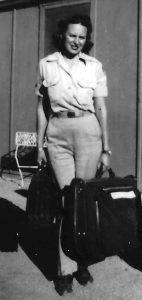 Evelyn Sharp
Evelyn SharpAnd then there was Evelyn Sharp. Accepted into the WAFS on October 20, 1942 — her 23rdbirthday — Evelyn had logged an impressive 2,968 hours by the time she joined the WAFS.
Evelyn was the fourth woman, after Nancy Love, Betty Gillies and Barbara Erickson, to check out in the twin-engine P-38. She did so on March 26, 1944. Over the next three days she familiarized herself with the working of this magnificent aircraft with its two 1,425 horsepower engines. On March 29, she completed her transition.
Evelyn Sharp the Third WAFS to PerishWe know the rest of the story. The following day she set her P-38 on a course for the docks at Newark, NJ — clear across the country. It was a trip she had made countless times in a P-51. On April 3, after being weathered in overnight in New Cumberland, PA — and having had problems with oil levels in both engines — she took off. Barely in the air, her left engine belched black smoke and quit. Evelyn did not survive the subsequent crash. The impact drove the retracted nosewheel up into the cockpit and threw Evelyn into the bubble canopy breaking her neck.
Nancy Love had lost her third Original WAFS. That young woman who had put many a 1930s canvas, dope and plywood aircraft down in the fields of Nebraska when learning to fly, gave it her all and tried to bring the steel and aluminum dynamo back to earth safely. To no avail.
Hometown Airports Named for All ThreeAll three of the original WAFS who died while flying for the Army Air Forces in World War II were memorialized when a hometown airport was named for them: Evelyn Sharp Field — Ord Municipal Airport, Ord, Nebraska; Dorothy Scott Memorial International Airport, Oroville, Washington; and Cornelia Fort Airpark, a small private airport located on the banks of the Cumberland River in Nashville Tennessee. Unfortunately, the airpark no longer exists. It was flooded beyond repair in 2010. Now, what was the airport, is part of Nashville’s Shelby Bottoms Greenway and Nature Park.
Tennessee’s own Rob Simbeck wrote the story of his fellow Nashvillian, Cornelia Fort. Daughter of the Air was published in 1999. Nebraska’s own Diane Ruth Armour Bartels—who is a Nebraska Ninety-Nine—wrote Sharpie: The Life Story of Evelyn Sharp, published in 1996.
And yours truly, Sarah Byrn Rickman, wrote Finding Dorothy Scott,(published 2016). Dorothy’s twin brother, Edward Scott, donated her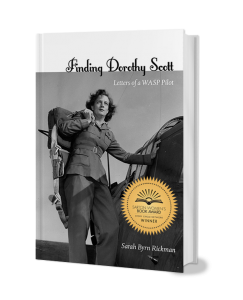 letters to the WASP Archives at TWU. Using her letters to tell her incredible story was a labor of love.
letters to the WASP Archives at TWU. Using her letters to tell her incredible story was a labor of love.
Then I, too, wrote about Cornelia. Published by Flight to Destiny Press March 2023:
Cornelia Fort WAFS Pilot: Her Life for Her Country is aimed primarily at today’s young women – our women pilots of the future – the most recent to celebrate the WASP’s wonderful gift to women’s aviation. Adult women will enjoy the book as well.
Fort WAFS Pilot: Her Life for Her Country is aimed primarily at today’s young women – our women pilots of the future – the most recent to celebrate the WASP’s wonderful gift to women’s aviation. Adult women will enjoy the book as well.
Both Finding Dorothy Scott and Cornelia Fort WAFS Pilot are available on Amazon.
Cornelia’s, Dorothy’s and Evelyn’s stories live on.
The post The WASP: In Observation of Memorial Day first appeared on Sarah Byrn Rickman.
April 7, 2023
Cornelia Fort – Her Life for Her Country
BE FOREWARNED: THIS STORY WILL BREAK YOUR HEART
The heroine dies in the end, but you already know that. So read on – walk, run, fly with this extraordinary young woman who, during her short life, used her gifts to try to better the world in which she lived. The story of Cornelia Clark Fort soars. Cornelia herself soared every time she stepped into the cockpit of the aircraft she was flying that day, from takeoff to landing – including her last flight. While doing her sworn duty to the best of her ability, she gave her life for her country when it was at war fighting for democracy and the right to live free. Principles she fervently believed in.
short life, used her gifts to try to better the world in which she lived. The story of Cornelia Clark Fort soars. Cornelia herself soared every time she stepped into the cockpit of the aircraft she was flying that day, from takeoff to landing – including her last flight. While doing her sworn duty to the best of her ability, she gave her life for her country when it was at war fighting for democracy and the right to live free. Principles she fervently believed in.
Know that in reading her story you will experience the best of what humanity has to offer. Flying along with this fine young pilot, who died too soon, you will learn what it feels like to dance with birds, chase clouds, and fly the wild blue yonder.
December 7, 1941 —“A Date Which Will Live In Infamy”MORNING BROKE as it always does in Hawaii, when the big red ball that is the sun rises from the middle of the Pacific Ocean east of the islands. Cornelia Fort nudged the control stick to the left, touched her foot to the left rudder pedal and put the small, single-engine airplane into a shallow bank. The right wing lifted and traced an invisible arc across the sky as the aircraft, its left wing now pointing down, swung through a 180-degree turn.
The early morning mist had vanished from the green valleys between the rugged mountains that looked down on the calm waters of Pearl Harbor. In the two-plus months she had been here, Cornelia had learned that the seasons in Hawaii did not change like they did in Tennessee. Back home, by early December, the trees on the gentle, rounded Green Hills south of Nashville were bare, and the sky took on that slate gray monochrome that comes in mid-November and stays until March. Here, in this tropical paradise, the world brimmed with sunshine; gloriously brilliant blossoms of red, purple, orange, and yellow; and smiling people.
She bit back a yawn. Cornelia had been up since before six. Her first student was scheduled to fly at 7:30 this Sunday morning at Honolulu’s John Rodgers Airport. It was a busy time. Boys in a hurry to become men were flocking to the airport to learn how to fly. They all had their eyes on the growing threat of a war. All gung-ho to learn how to fly the military’s basic training aircraft, which could lead them up the ladder to pilot the U.S. Army Air Forces’ faster, more powerful warplanes.
Flying for Her CountryErnest Suomala, the young man who sat in front of her in the enclosed, two-seat cockpit – one seat in front of the other – was her first student today. They had flown together before. She was finding him to be an apt student.
Cornelia had a full schedule ahead of her that Sunday, as did all the instructors. Most were booked from dawn until dusk. The winter solstice was but two weeks away. Sunset came earlier these days.
Sunday again, Cornelia thought and smiled to herself. Her dear mother would have apoplexy if she knew her darling daughter was flying on a Sunday – very much against the Fort family’s strict Episcopal upbringing. But her mother was back home, far across the ocean in distant Tennessee, and Cornelia kept her mother carefully sheltered from the knowledge that her no-longer-little girl was flying on, heaven forbid, Sundays!
When a scan of the sky told her no other airplanes were in the practice area, she tapped her student on the shoulder. “Let’s try some power stalls,” she yelled over the noise of the engine. “Your airplane,” she said, his clue to take the controls. “I have the airplane,” he said, the required response. Carburetor heat on, power off, stick back, nose up, back pressure, back, back some more. Suomala knew the drill well by now.
The Nose Climbed HigherCornelia watched as the nose of the plane climbed higher in the sky, her hands and feet resting lightly on her own set of controls, ready to take over in an instant if the young man failed to perform the maneuver correctly.
There it was, the “mushy” controls, the eerie silence. The little airplane hung, suspended. Then it kicked over to the right. Suomala did as Cornelia had taught him to do. Stick forward to neutral, power back on, carburetor heat off. All gentle but firm. Back to level flying.
You never could tell with students the first couple of times you took them up. The ones you expected to be bold often turned out to be the most timid once in the air, whereas the poor soul you thought was afraid of his own shadow might turn out to be a roughneck who tended to jerk the plane around all over the sky.
Teaching Young Men Her Age to FlyCornelia, twenty-two, was teaching young men her own age and younger how to fly. And she loved flying the little Interstate Cadet, a high-wing, single-engine trainer aircraft. Like many of the small training airplanes of the day, it was made of heavy cotton fabric stretched taut over an aluminum skeleton of fuselage and wings and painted a distinctive blue and yellow. She thought it the spiffiest airplane around.
“Very nice,” she called out when Suomala completed three successful stalls. Then she put him to work negotiating 360-degree turns, first to the right and then to the left, to be accomplished without gaining or losing altitude. “And keep your eye on the altimeter,” she reminded him.
Below lay the rainforest – so dense, so verdant, so intense in the early morning sun that it almost hurt to look at it. Lulled by the drone of the engine, mesmerized into a momentary complacency no flight instructor could afford, Cornelia forced herself to look past her student’s broad back and beyond the windscreen. She could see the crests of the hills and farther out, the brilliant gem-blue of the Pacific Ocean.
Moving Specks in the Distance!Then in the distance she saw moving specks. What were they? A flock of birds? Too big. Airplanes? She squinted through the windscreen. The specks – yes, airplanes – and they were coming toward her.
“What’s that, Miss Fort?” Suomala asked. He, too, had spotted them.
Now she could make out a formation – dozens of planes. They resembled a swarm of angry bees. Seconds later, the lead aircraft banked right and turned south. She caught sight of a large, red circle on the wings. The other airplanes followed the leader. All but one. The last plane peeled off and flew toward them. Alarm bells went off in her brain. Her thoughts raced: The red ball. The Rising Sun? Japanese? Why?
That sleek, silver airplane was heading right toward them. They were on a collision course, and their much smaller, slower aircraft was the vulnerable one. “Let’s get outta here,” she yelled, grabbing the controls from her student.
Cornelia Fort WAFS Pilot is available on Amazon.com. Buy it here
The post Cornelia Fort – Her Life for Her Country first appeared on Sarah Byrn Rickman.
March 9, 2023
Must Read: CORNELIA FORT WAFS PILOT
 Cornelia Clark Fort
Cornelia Clark FortPhoto courtesy the WASP Archive, Texas Woman’s University
Know that in reading Cornelia Fort’s story you will experience the best of what humanity has to offer. Flying along with this fine young pilot, who died too soon, you will learn what it feels like to dance with birds, chase clouds, and fly the wild blue yonder.
Cornelia Fort WAFS Pilot: Her Life for Her Country is now available on Amazon as a trade paperback book. Cornelia’s story is my sixth and final WAFS/WASP of WWII biography in a series written for readers age 12 and up. A Kindle e-book will be available soon.
This is my 13th book about the experienced and very dedicated American women pilots who flew military aircraft in World War II. The first – The Originals: The Women’s Auxiliary Ferrying Squadron of WWII – was published in 2001.
Amelia Earhart Led The Way For Women PilotsCornelia’s story – like the other five biographies in this series – is aimed at today’s middle school and high school age girls. Why?
I was thirteen when I discovered Amelia Earhart – still today America’s most famous woman pilot. Her chapter in my Ninth Grade English textbook about famous Americans was the only one that featured a woman. Destiny was on my side. Meeting Amelia between the pages of that book ultimately sent me on a journey to discover the women pilots who followed in her footsteps – the women of the next generation who, like “AE”, longed to fly and did!
Those women became the 303 ferry pilots who – as civilians – flew for the Air Transport Command, U.S. Army Air Forces in World War II. They were known first as the WAFS (Women’s Auxiliary Ferrying Squadron) and later as the WASP (Women Airforce Service Pilots). Note: to ferry an aircraft is to fly it from one location to another.
Meeting These Women Changed My LifeI was fortunate enough to meet several of these women in the 1990s. I listened to and fell in love with their stories. The initial encounter – still vivid in my mind and described in detail in the Introduction to The Originals – changed my life. The result today, 12 more books – six of them aimed at these younger women and concluding now with the publication of Cornelia Fort’s extraordinary story.
At the core of her story is her romance with flight. It begins the day she takes her very first flight and, in the process, finds her life’s journey. Flying became Cornelia’s “raison d’etre” – her reason for being and her joy in living. Ultimately, it took her life. To honor her, the WAFS dedicated a special ferrying flight in her name.
I hope you’ll like Cornelia Fort WAFS Pilot! 
Sarah Byrn Rickman
Check out Cornelia Fort on Amazon.
The post Must Read: CORNELIA FORT WAFS PILOT first appeared on Sarah Byrn Rickman.

